On one rainy February morning in 2005, Shane and I walked along the Cheakamus River, hoping to connect with a silver winter steelhead. After hiking and fishing through a large section of the river, we came across one run that seemed extremely fishy. There had to be a fish laying in it.
I made a long cast out and allowed the large pink rubber worm drifting gently down the flow. Suddenly the float was buried. The dive was too swift to be a snag, it was a fish! I yanked the rod back beyond my shoulders and watched the rod kicked down furiously. Before I had a chance to scream “Fish on!”, it darted toward me and made a big splash right in front of Shane as I frantically tried to pick up the slack line on my centerpin reel. It was silver, it was one of the largest steelhead that I had ever seen on my line. Shivering from the cold and the excitement, I walked downstream slowly as the fish used the current as its advantage to escape. After a few minutes of tugging, it emerged on the surface and slowly made its way toward me. I reached my hand out, thinking that it was ready to be tailed but only to be startled by another burst of its energy. It splashed several times on the surface and the hook fell out of its mouth. I looked back at Shane, who looked at me with the “What were you thinking?” look.

Still fueled with adrenaline, I went straight back to where I had connected with the fish and made another cast. As if I had orchestrated, the float once again disappeared beneath the surface! Another fish made its splashy appearance on the surface as I attempted to pick up the slack line once again. It was a smaller fish, but still very solid. It was almost a replay of the previous fight. I made my way down to where I had previously lost the fish and prepared to land the fish. Just when I thought that I had it this time, the fish managed to go behind a rock and rubbed the leader a few times. As expected, the leader suddenly snapped and all I could do was to hopelessly watch it swimming away. Shane let out a loud chuckle behind me. What a disappointment it was, two steelhead hooked without being able to photograph with them. Nevertheless, these beauties were on their way to produce more offsprings to ensure the future of this unique steelhead run.

That future was instantly shattered several months later, when a sodium hydroxide spill due to the derailment of a CN Rail train killed almost every living organisms downstream from it. Offsprings of these trophy steelhead, were surely wiped out, among with other juvenile steelhead runs that had also been rearing in the river since the previous year.
The spill also jeopardized the pink salmon return, which was poor in the following return year (2007). The Cheakamus River and other tributaries of the Squamish River, have always given me memorable angling experiences since I was introduced to them in 1995. In the winter months we have had the opportunities to catch many bull trout, cutthroat trout, rainbow trout and steelhead. In the fall months, its chum and coho salmon fisheries have given us many wonderful days with multiple large chrome fish captured. There are not many places in the world where you can experience this type of quality fishery, especially being only one hour from a populated city.

Since the disastrous spill, efforts have been made to restore these lost populations. The short term result has not been very positive. The salmon and steelhead returns in the Squamish River have been dismal in the last couple of years. Anglers used to visit, enjoy and celebrate the return of these fish between September and April. This is no longer the case. The river is empty of fish, fishers and other animals that depend on them. Despite of its grim state, volunteers have not given up by continuing its restoration, hoping to revive it in the long run.
The coffin is not fully closed yet, but it seems like it is about to be nailed. The currently proposed Garibaldi at Squamish project aims to create a Whistler-like ski resort that will accommodate over 15,000 users at one time. beside the obvious concern of development over natural land that we already enjoy recreationally, the largest concern that anglers and river stewards have is the capacity of its required water usage. Its plan is to utilize the headwater of Brohm Creek as the source of its water supply. This, in my opinion, is environmentally irresponsible. Brohm Creek is one of few tributaries of the Cheakamus River where salmonids such as steelhead spawn. Headwater is the source of a creek’s discharge. By drawing water from it to supply the resort’s need, it ultimately puts an end to the future of the Cheakamus River steelhead, which is already uncertain. In a world where concerns of water shortage crisis is growing rapidly, it is unbelievable that projects at this magnitude are even being considered.
We are currently seeing the killing of a river that has served many of us well. I would like to experience that rainy February morning in 2005 again, but it could only be relived by a few photographs if projects such as this are approved. The natural landscape and wildlife in the Squamish region already provide limitless recreational opportunities to anglers, hikers, mountain bikers, rockclimbers and many others. Do we need another manufactured “nature” experience that requires us to pay a significant sum of money to enjoy? This province markets its tourism as Supernatural BC, there is nothing natural about this development.
What can you do as a concerned angler? You can voice your concerns! The Environmental Assessment Office is currently accepting comments from the public before July 19th. Simply download this PDF file, print it, fill it and mail it to the address provided on the form. If you do not have a printer, we will have forms available at this year’s Fish for the Future for you to fill out. I will even mail it for you.
It is not only your responsibility to protect the few fish left in the Cheakamus River, but it should also be your interest to see better fishing like what many used to experience in the past. Please don’t stand by and regret when it is lost beyond recovery.
Here is a news video clip from Global BC in late 2008 that provides some background information on Brohm Creek.

 Â
 

